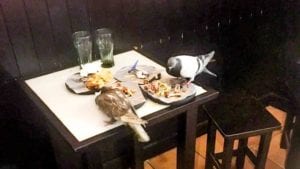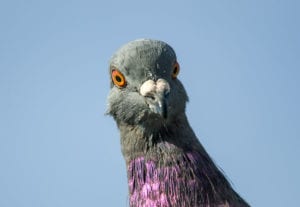
Cadiz Cathedral in Spain is facing a pigeon infestation.
Laura Perez Maestro, CNN • Updated 13th December 2018
(CNN) — It’s always nice to share a meal with the locals on vacation, except when the locals steal your food, smash your plate, defecate on the table — and then fly away. Cadiz has been facing this exact pigeon problem.
That’s the situation in the southwestern Spanish port town of Cádiz where pigeons have been terrorizing tourists to such an extent that local authorities are now taking steps to banish thousands of birds.
“We are not exaggerating, the pigeons are not scared of humans any more,” Carlos Fernández, the manager of one of the restaurants in Cádiz’s beautiful Cathedral Square, tells CNN.
“They throw themselves at the food even when there are clients seating ready to eat it. They push glasses, plates and jars on to the floor and it’s a real mess.”
And when tourists give up on Cádiz’s sunny terraces and move inside, there’s still no escape from the birds, Fernández says.
“Even inside the restaurant, they come in, they know where the food is and that we don’t do anything to them, they are not scared”, adds Fernández.

Brazen Pigeons feeding directly from the table.
He says that the population of pigeons is now so high that customers pestered by the pigeons are being scarred by their experiences. “They don’t come back.”
It’s not a pretty picture either. The square’s winged residents “decorate” building facades and restaurant tables and chairs. They even make the ground difficult to walk on, says Fernández.
After a pigeon census by the city council decreed that the bird population of 9,000 was three times as many as Cádiz could sustain, authorities decided to take steps.
The plan is to catch and relocate 5,000 pigeons over a period of a year instead of culling them. They’ll then be transported at least 170 miles away — a distance hoped to discourage them from returning.
Alvaro de la Fuente, of the council’s environmental department, says the city wants “a respectful and sustainable solution to reduce the impact of the birds on cities like Cádiz.”
He adds that by relocating rather than exterminating the birds, Cádiz hopes to “establish a logical equilibrium where the cohabitation between humans and birds doesn’t damage either.”
The local government is confident this project will work because, although pigeons have strong homing instincts, once you take them beyond 170 miles from their home they tend to stay and settle in their new surroundings.
Some 3,000 leaflets instructing people to stop feeding the birds are also being distributed to make the change a little bit easier.

Health risks
Cádiz’s hoteliers, who say they’ve lost 20% of their business because of the pigeons and warned of health risks to their employees, welcome the relocation plan but want it implemented ASAP.
“It’s been years since we brought up the problem and started talking with the city hall,” says Antonio de María, president of Cádiz hoteliers association, Horeca.
“A few months ago, we were presented with a plan to move the pigeons to another city but they now say they need a health assessment on the pigeons that will be moved, so the project keeps getting delayed.”
Cádiz is not the only city with bird problems. In November, Rome’s authorities began using falcons to drive thousands of starlings out of the ancient city.
